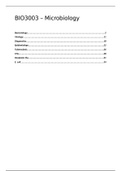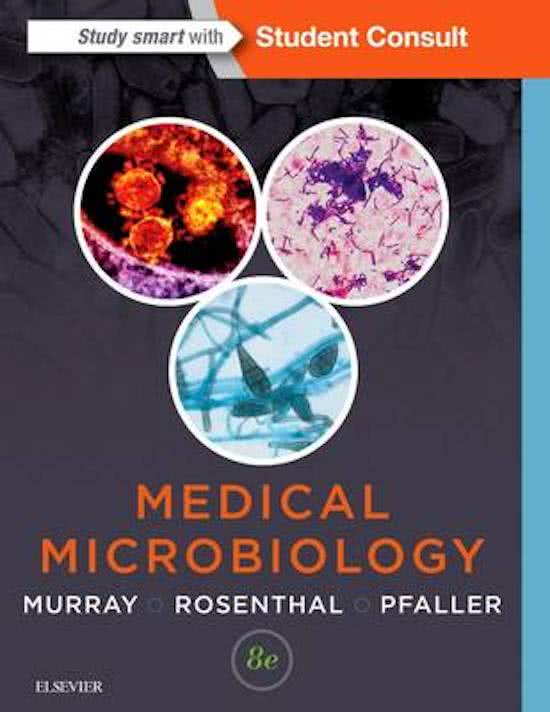BIO3003 – Microbiology
Bacteriology.......................................................................................................................2
Virology...........................................................................................................................11
Diagnostics......................................................................................................................18
Epidemiology...................................................................................................................22
Tuberculosis.....................................................................................................................26
STIs..................................................................................................................................28
Pandemic Flu....................................................................................................................31
E. coli...............................................................................................................................34
,Bacteriology
Microbiology is the study of microorganisms, including parasites, fungi, viruses and
bacteria. Bacteria are ubiquitous (found everywhere) eukaryotic microorganisms, 1-5 um in
size, they have a fast multiplication rate and live in colonies, which is a population of cells
descendant from one single multiplying ancestor.
Prokaryotes: single celled, cytoplasmic membrane (takes care of respiration), no
nucleus, no lysosomes, peroxisomes, ER, microtubules, cytoskeleton and Golgi
apparatus, DNA called nucleoid freely floating, single double stranded circular
chromosome, haploid genome, reproduction by binary fusion, long cell cycle, genes
expressed in groups called operons, cell wall present, smaller ribosomes (70S), co-
translational. (bacteria and archaea, > 0.5 um)
Eukaryotes: multicellular, mitochondria (site of respiration), nucleus, linear DNA
bound by nuclear membrane, multiple linear chromosomes, reproduction by mitotic
or meiotic division, short cell cycle, genes expressed individually, cell wall only
present in plants, bigger ribosomes (80S), perform post translational modification.
(animals, plants, fungi, algae, protozoans, >5 um)
Functions of bacteria include the production of metabolites (vitamin K), stimulation of
immune system and prevention of colonization of exogenous bacteria.
Commensal bacteria (99%): live in symbiosis with the host (like bacteria on and in
the body). We are free of bacteria at birth, after which rapid colonization from the
environment occurs to create a personal normal flora. Influencing factors are diet,
stress, probiotics, age (babies vs older people) and antibiotic use (transient and
partial elimination of microbia). All bacteria have their own habitat, they colonize
different parts of the body meaning some locations are full of bacteria and others
are completely sterile:
o Most bacteria present on skin, mucosa of airways, mucosa of gastro-
intestinal tract, and mucosa of uro-genital tract. More bacteria towards
colon, provide barrier to pathogenic organisms, help with fermentation of
dietary fibers, synthesize vitamin B12 and K and folate, provide growth
factors, help balance the immune system/keep it active, provide homeostasis
and help produce serotonin (mostly gram-negative bacteria present,
anaerobic and aerobic bacteria present).
Dysbiosis (disbalance) of microbiome affects different organs,
resulting in anxiety, depression, diabetes, inflammatory bowel
disease, pulmonary disease, atopy, allergies, carcinogenesis, obesity,
atherosclerosis, non-alcoholic fatty liver disease.
o Sterile regions include bladder, brain, circulatory system, bone, etc. (pili,
lysosomes, protein defenses, mucosa make regions sterile)
Opportunistic pathogens: do not always cause disease, take advantage of pre-
existing conditions to grow and cause serious disease. Naturally present bacteria
become violent due to decreased immunity of the host or when they enter sterile
sites of the body.
Strict pathogens: will always cause disease.
Pathogenic bacteria (±1%): always cause disease (even in healthy patients), promote
their growth in the host at the expense of the host’s tissue or organ function.
, Commensal bacteria become pathogenic after they obtain new genetic material
(DNA) which codes for a violence factor (toxins/plasmids/ cytokines) that makes
them able to cause disease. Many of the virulence factors consist of complex
structures or activities that are only expressed under special conditions. (type 3
secretion system)
o Pathogenicity islands are large genetic regions present in the bacterial
chromosome or on plasmids that contain sets of genes encoding numerous
virulence factors with coordinated expression. They can be transferred as a
unit to different sites within a chromosome and to other bacteria. Genes may
be turned on by a single stimulus (temperature/pH/lysosome).
Bacteria have traits that enable them to enter/invade the environment, remain a niche
(adhere/colonize), gain access to food sources (degradative enzymes), sequester ions (iron)
and escape clearance by host immune and nonimmune protective responses (capsule).
When sufficient numbers of bacteria are present (quorum), they start producing a biofilm,
which is a well-organized group of microorganisms encapsulated within ECM (water,
polysaccharides, proteins, DNA) to support the colony, resulting in a high growth rate.
A biofilm is less or unaffected by antibiotics, because of slow penetration, resistant
phenotypic cells and an altered microenvironment (except positively charged
hydrophobic antibiotics and a negatively charged matrix)
Products used to maintain their niche and byproducts of bacterial growth (virulence factors,
acids/gases) can cause damage and problems for the host, like tissue damage or release of
toxins/exotoxins (released/secreted into the surroundings)/endotoxins (incorporated into
the cell wall/membrane) which enter the blood. The combination of tissue damage and
consequences of the innate and immune (inflammatory) responses to the infection
ultimately leads to disease. Signs and symptoms are determined by the change to the
affected tissue.
Quorum sensing: cell-cell communication system, the regulation of gene expression
of bacteria in response to fluctuations in cell-population density. Bacteria produce,
and release chemical signal molecules called auto inducers (AHL) that increase in
concentration as a function of cell density
within the biofilm and lead to alterations
in gene expression to regulate
physiological activity (symbiosis, virulence,
competence, conjugation, antibiotic
production, motility, sporulation and
biofilm formation, secretion of virulence
factors, bioluminescence production,
swarming motility)
Koch’s postulates are four criteria designed to establish a causative relationship between a
microbe and a disease.
1. The microorganism must be found in abundance in all organisms suffering from the
disease and should not be found in healthy organisms.
, 2. The microorganism must be isolated from a diseased organism and grown in pure
culture.
3. The cultures microorganism should cause disease when introduced into a healthy
organism.
4. The microorganism must be reisolated from the inoculated diseased experimental
host and identified as being identical to the original specific causative agent.
The basic lay-out of a bacterial cell is as follows:
Capsule: polysaccharide outer coating, slime layer,
important virulence factor, protection against host immune
cells, attachment.
Cell wall: support, shape, protection
o Gram positive: multiple peptidoglycan layers (±40),
(lipo)teichoic acid and cell wall associated proteins.
o Gram negative: few peptidoglycan layers (±2),
outer membrane of phospholipids containing LPS
lipopolysaccharide (LPS) and porins and
periplasmic space.
LPS: triple structure (endotoxin/lipid A,
core polysaccharide and repeating
unit/O-antigen).
o Acid-fast: lipid dense cell wall
o Spirochaete: diderm, double membrane
o Mycoplasma: no cell wall
Cytoplasmic membrane: lipid bilayer, no sterols, most important metabolic organ,
responsible for passive transport (diffusion and facilitated diffusion) and active
transport of nutrients from the environment.
Cytoplasm: containing
o Nucleoid: circular supercoiled genome/chromosome (DNA) + plasmids (no
membrane)
o 70S ribosomes
o Reserve granules
o Metabolic intermediates
o No organelles
Flagellum: locomotion/movement, ‘whip’
Pili/fimbrae: contain adhesins/adhesion proteins for adherence/attachment,
protection from host immune system, move DNA from one bacteria to another, most
common in gram negative bacteria.
Spores: produced by some bacteria, outside the cell, genetic material not able to be
translated into protein
The bacterial genome is the total collection of genes carried by a bacterium. Bacteria usually
have only one copy of their chromosomes (haploid, mutation has more obvious effect on
the cell). During their replication cycle, new DNA is synthesized semi conservatively, using
both strands of the parental DNA as templates. DNA replication is followed by cell
elongation and division into 2 daughter cells.





